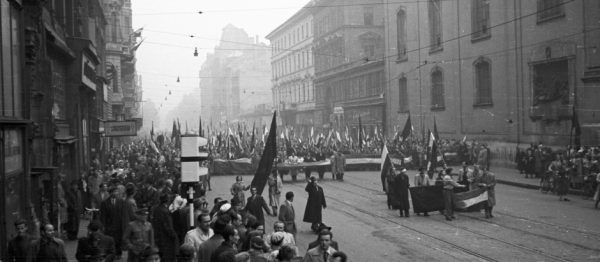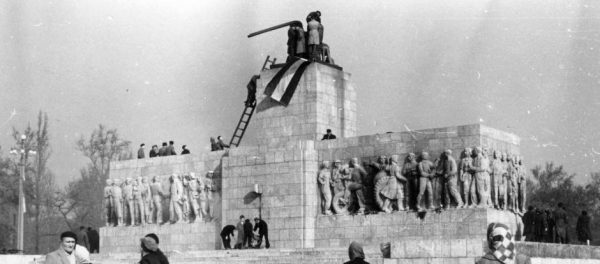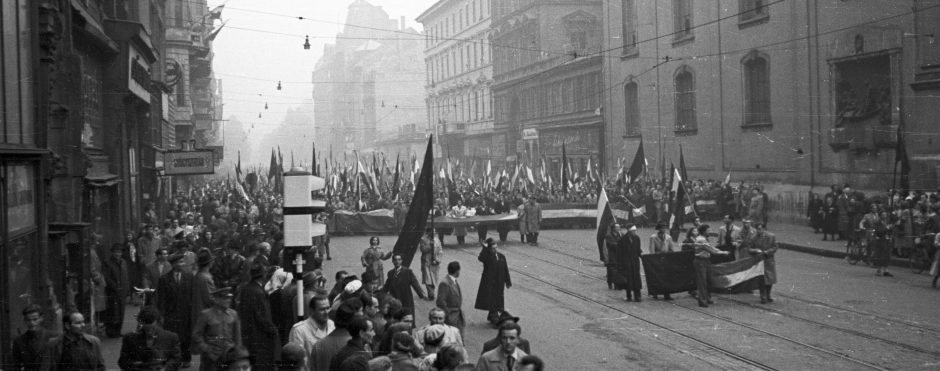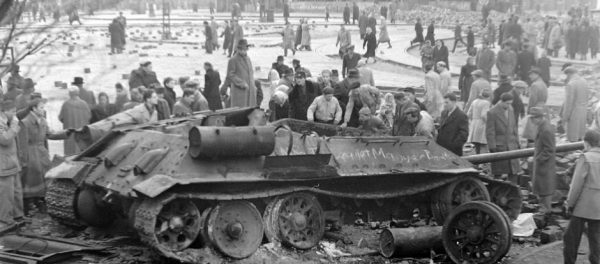Source:El Debate
In 1940 Hungary joined the Axis and then participated in the invasion of Yugoslavia and Hitler’s attack on the Soviet Union. This war cost Hungary 300,000 soldiers and 80,000 civilian deaths
Subsequently, as the war progressed, Hungary attempted to make a separate peace with the Allies, prompting Hitler to launch Operation Margarethe on 19 March 1944. German troops occupied Hungary. There was no armed resistance from the Hungarian troops. Regent Horthy accepted the occupation and remained in power. On 4 April 1945 the last German troops were driven out of Hungarian territory by Soviet divisions. On 1 February 1946 the monarchy was abolished and the Second Hungarian Republic was proclaimed.
Immediate post-war Hungary was eventually ruled by a Soviet puppet government, becoming part of the communist bloc. Stalin reneged on agreements with the Allies to allow the people liberated from Nazi occupation to decide their future in freedom. In 1949, the Hungarian People’s Republic was born, a totalitarian system that lasted until the revolutions of 1989, which marked the end of communism in Hungary. Russian communists and their Hungarian pawns ruled the country dictatorially for 50 endless years.
Coalition government with communists
The Soviets ensured that the new post-war government was dominated by their communist pawns. Moscow acted to prevent the transfer of authority to the Magyar people. In elections held in November 1945, the Smallholders’ Party won 57% of the vote. The Hungarian Communist Party, under the leadership of Mátyás Rákosi and Erno Gero, received the support of 17% of the population. The Soviet commander in Hungary, Marshal Voroshílov, opposed the Smallholders’ Party forming a government. Instead, Voroshilov established a coalition government with the communists. The communist dictatorship was completed on 18 August 1949 when, after a one-party election, Hungary became the Hungarian People’s Republic. From this point on, the presence of Soviet troops in Hungary was made permanent by the 1949 Treaty of Mutual Assistance.

Kossuth Lajos Street as seen from Ferenciek Square: anti-Soviet demonstrators march in protest against USSR control of Hungary, 25 October 1956
With Mátyás Rákosi in power, Államvédelmi Hatóság (ÁVH), the Hungarian political police, purged more than 7,000 dissidents denounced as “Titoists” or “Western agents”, forced to confess in farcical court cases, and then murdered or sent to concentration camps in the east of the country. Hungary became a pro-Soviet people’s republic, under a Stalinist-style one-party political regime.
The Hungarian Communist Party imposed a socialist economy and undertook radical nationalisation based on the Soviet model, resulting in economic stagnation that impoverished Hungarians and generated deep unrest. From 1950 to 1952, the ÁVH deported thousands of people to obtain property and housing for members of the Hungarian Workers’ Party. Many Magyars were arrested, tortured and imprisoned in concentration camps, deported to the East or executed, including ÁVH founder László Rajk. In just one year 26,000 Hungarians were relocated outside Budapest. The deportees suffered terrible living conditions and were forced to become semi-slave labour on collective farms. Many died as a result of poor living conditions and malnutrition.
On 5 March 1953, Stalin died. Nikita Khrushchev took over the leadership of the Soviet Union. On 24 February 1956, shortly after arriving in the Kremlin, Khrushchev spoke at the 20th Congress of the Communist Party of the Soviet Union, denouncing the crimes of Stalinism. His words gave hope to the countries of Eastern Europe who saw his coming to power in the USSR as the end of the Soviet dictatorship.
Protests against communism
Intellectuals, writers and journalists were the first to openly express their criticism of Hungary’s communist government. On 22 October 1956, students at the Technical University revived the hitherto banned student council, MEFESZ, and organised the first protests. On 23 October 1956 the Hungarian people took to the streets demanding freedom. It all began with a student protest, which attracted thousands of people who marched through the streets of Budapest. A group of university students were arrested when they tried to enter the headquarters of the Hungarian Radio. All over Hungary, people were demanding an end to the oppression of Hungarians by the secret police of the communist government with the support of the Soviet army.

In Budapest, anti-communists and nationalists place a Hungarian national flag on a demolished statue of Josef Stalin
The ÁVH opened fire on the demonstrators. Soviet troops fired on the ÁVH, believing they were under attack. Some demonstrators obtained weapons taken from the police or handed over by Hungarian soldiers who joined the uprising. The insurrection spread throughout Hungary. The government of the communist András Hegedüs was overthrown. Soldiers and civilians organised themselves into armed militias to fight the ÁVH and Soviet troops. Pro-Soviet Hungarian communists and members of the ÁVH paid with their lives for their resistance to the insurrection or were imprisoned, while political prisoners of the communist regime were released. The new government headed by Imre Nagy formally dissolved the ÁVH, declaring its intention to withdraw from the Warsaw Pact and promising to re-establish free elections. By the end of October, the fighting had all but ceased and Hungary was embarking on a new journey away from Soviet dictatorship.
The Politburo (Russian communist government) announced the withdrawal of Soviet occupation forces as the Red Army moved in to crush the Hungarian revolt. Westerners divided over the Suez crisis (occupation of the Suez Canal by British and French troops), which had been nationalised by Egyptian leader Nasser, did nothing to prevent Moscow’s action. The Soviet Army mobilised more than 30,000 troops and more than a thousand tanks. On 4 November 1956, the Soviets returned in force to Hungary. The Hungarian resistance ended on 10 November. 2,500 Hungarians and 722 Soviet soldiers perished in the conflict and some 200,000 Hungarians fled their country. The repression that followed was brutal. By January 1957 the new Soviet-installed government led by János Kádár had suppressed all opposition.
Moscow showed who was the undisputed master of Eastern Europe and that the Soviet leadership was determined to use all the force at its disposal to put an end to any kind of opposition and dissent. Imre Nagy was executed along with Pál Maléter and Miklós Gimes, after secret trials, in June 1958. Their bodies were buried in unmarked graves in a municipal cemetery on the outskirts of Budapest. It was not until 1963 that the political prisoners of the Hungarian uprising were released.
Share this article
On This Day
- 1528 Prince Felipe is sworn as heir to the Spanish kingdoms in Madrid.
- 1593 The city of San Salvador de Jujuy (Argentina) is founded by Francisco Argañaraz y Murguía.
- 1776 Battle of Lexington and Concord (United States).
History of Spain
26 August 2020
27 January 2021
Communism: Now and Then
23 December 2022
28 July 2021







